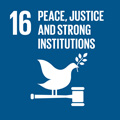- Docente: Domenico Guzzo
- Credits: 10
- SSD: SPS/06
- Language: Italian
- Teaching Mode: Traditional lectures
- Campus: Forli
- Corso: First cycle degree programme (L) in International relations and diplomatic affairs (cod. 8048)
-
from Feb 18, 2025 to May 23, 2025
Learning outcomes
The course aims to provide adequate knowledge of the theoretical and cultural foundations underlying the choice and exercise of political violence, with particular interest in democratic state contexts. At the end of the course students will have deepened methodological aspects related to the definitions of subversion and terrorism, in the broader framework of political violence manifestations; the history of political violence and terrorism in the contemporary age: origins, development, phenomenology, contiguity and exploitation, strategic purposes, reactions of the security apparatuses, reasons for decline. Italy will represent the main case study, but a constant comparative analysis will be maintained with the most important international events related to the topic
Course contents
The course consists of a first methodological part, in which the precise terminologies related to the definitions of subversion/ subversion and terrorism will be conveyed, within the broader framework of the manifestations of political violence.
This will be followed by a second part focusing on the theoretical and cultural foundations underlying the choice and exercise of political violence, with particular interest in democratic state contexts.
The third part, the densest and most extensive, will be devoted to the history of political violence and terrorism in the contemporary age: origins, development, operational phenomenology, contiguity and instrumentalisation, strategic aims, reactions of the security apparatuses, reasons for the decline.
Due to its extension, virulence and incidence, Italy will represent the main case study, but a constant comparative analysis will be maintained with the most important international events connected to the theme (the Colonels' coup in Greece, the French OAS bombs, the RAF armed group in Germany, the actions of the IRA in Ireland and the Eta in Spain, the Palestinian attacks in Europe since Munich 1972, ...).
It begins with the thoughts and actions of Felice Orsini, the first prototype of the modern terrorist, executed in 1858 for attempting to assassinate the French emperor Napoleon III with grenades, It then goes on to study the "acts of tyrannicide" (the so-called "propaganda of fact") committed by anarchists at the turn of the 19th and 20th centuries (including the assassinations by Italian anarchists of French President Sadi Carnot, Spanish President Canovas del Castilllo, Princess Sissi of Austria-Hungary and King Umberto I of Italy).
After the epochal impact of the Bolshevik Revolution and the Red Terror, and the characteristics and consequences of Fascist and Nazi political violence, we will focus on the post-war period, beginning with the Portella della Ginestra massacre (1947) and the bombings in South Tyrol (1956-1967): This led to the period of greatest virulence, characterised by indiscriminate massacres - carried out by extreme right-wing terrorists - and the coup plots of the "strategy of tension" (1969-1974), followed by the armed struggle of the clandestine ultra-left groups (1975-1988), which reached its climax with the bloody kidnapping and assassination of the most important politician of the time, Aldo Moro. A dutiful focus on the murder of Senator Prof. Roberto Ruffilli, which took place in Forlì on 16 April 1988, will conclude the excursus.
The last part will focus on the solid (and decisive) reactions of Italian civil society to the development of political violence and the concretisation of the terrorist threat - which will lead to the exit from the tunnel of armed struggle - and will conclude with a critical examination of the concrete conditioning effects of the "strategy of tension" and the "years of lead" on the socio-political dynamics of the country, without neglecting to highlight the contemporaneous transition of terrorist operational models (starting with the massacre of the Rapido 904 on 23 December 1984, copied from the Italicus train massacre ten years earlier) and contrasting legislation (the regime of special prisons, pentitism, ...) from the old armed forces. ...) from the old armed groups to the mafia organisations.
Readings/Bibliography
There is a monograph that should be studied in its entirety:
- Francesco Benigno, Terrore e terrorismo. Saggio storico sulla violenza politica, Einaudi, Torino 2018.
Following the specific indications provided by the lecturer, the student will have to move among other ‘basic readings’, making them - in primis - a tool to complement the themes and events dealt with in class; and, in secundis, the starting point for the elaboration and drafting of the in-depth thesis to be discussed during the oral exam (on the exam, see the specific section below).
Basic readings:
- Enzo Traverso, A ferro e fuoco. La guerra civile europea 1914-1945, Il Mulino, Bologna 2008. (capitoli I, II, III, VII)
- Luigi Migliorino, L’Italia e il terrorismo internazionale, in L. Bonanate (a cura di), Dimensioni del terrorismo politico: aspetti interni e internazionali, politici e giuridici, FrancoAngeli, Milano 1979.
- Valentine Lomellini, Il «Lodo Moro». Terrorismo e ragion di Stato 1969-1986, Laterza, Roma-Bari, 2022.
- Sergio Zavoli, La notte della Repubblica, Mondadori, Milano 1992.
- Sara Tavani, Lo sguardo di Mosca sul terrorismo italiano degli anni Settanta ricostruito attraverso la stampa accademica e governativa sovietica, in V. Lomellini (a cura di), Il mondo della guerra fredda e l’Italia degli anni di piombo, Mondadori-Le Monnier, Firenze 2017.
- Lucrezia Cominelli, La strategia americana nei confronti dell'Italia e le sue ricadute sull'eversione di destra, in C. Fumian e A. Ventrone (a cura di), Il terrorismo di destra e di sinistra in Italia e in Europa : storici e magistrati a confronto, Padova UP, Padova 2018.
- Marco Cuzzi, Mirco Dondi, Domenico Guzzo (a cura di), La strategia della tensione tra piazza Fontana e l'Italicus. Fenomenologia, rappresentazioni, memoria, Biblion, Milano 2022
- Raimondo Catanzaro (a cura di), Ideologie, movimenti, terrorismi, Il Mulino, Bologna 1990, pp. 47-111; 153-214.
- Giorgio Galli, Piombo Rosso. La storia completa della lotta armata in Italia dal 1970 a oggi, Baldini Castoldi Dalai, Milano 2005, pp. 236-249; 299-338.
- Domenico Guzzo, “Quando due elementi sono in lotta e sono irriducibili, la soluzione è la forza”. L'assillo della Rivoluzione e il dilagare della violenza politica nella mancata normalizzazione del dopoguerra, in C. De Maria (a cura di), Dalla fine della guerra alla nascita del fascismo. Un punto di vista regionale sulla crisi del primo dopoguerra (Emilia-Romagna, 1918-1920), Pendragon, Bologna 2019.
- Domenico Guzzo, L'assordante silenzio "nero" e le ostentate rivendicazioni "rosse": gli antitetici modelli comunicativi dei due terrorismi italiani, in “Sicurezza e Scienze Sociali”, n. 2, maggio/agosto 2017, pp. 17-32.
- Simone Neri Serneri, Il movimento del ‘77 e la crisi italiana degli anni Settanta, in D. Guzzo (a cura di), Da “non garantiti a precari”. Il movimento del ‘77 e la crisi del lavoro nell’Italia post-fordista, FrancoAngeli, Milano 2019.
- Angelo Ventrone, Una guerra civile di lunga durata. La violenza politica in un Paese a “capitalismo avanzato”, in “Meridiana”, n. 1, 2013, pp. 155-175.
- Domenico Guzzo, L’opinione pubblica italiana di fronte agli ultimi omicidi brigatisti degli anni Ottanta, in R. Brizzi et al. (a cura di), L'Italia del terrorismo: partiti, istituzioni e società, Carocci, Roma, 2021.
- Giuseppe De Lutiis, Moventi e motivazioni della dissociazione, in R. Catanzaro, La politica della violenza, Il Mulino, Bologna 1990, pp. 173-200
Teaching methods
The course will take place with physical presence in the classroom.
The course - which will make extensive use of iconographic and audiovisual repertoires of the period, archival documentation and mass media representations (including films) - will be constantly supported by slides and infographics, as well as moments of interactive discussion with the students, also mediated by the possible intervention of external experts.
Assessment methods
- Attending students:
- Two intermediate written tests (consisting of one block of pointed questions and four open questions) will be taken during the course.
- If the student passes both intermediate written tests, he/she will be admitted to the oral interview where he/she will discuss with the teacher the content and results of the in-depth study paper (on a topic of his/her choice from those proposed by the teacher during the course), which must be handed in at least 10 days before the call for applications.
- The paper, which must be accompanied by footnotes and a final bibliography, may range from a minimum of 20,000 characters (footnotes and spaces included) to a maximum of 30,000 characters (footnotes and spaces included). The bibliography is excluded from the calculation of the strokes.
- The final mark is made up of the average of the intermediate marks obtained in the written tests, the mark of the paper discussed at the oral exam, also taking into account any progress in learning and critical analysis ability recorded by the student.
- It will be possible - once only - to attempt to make up a single failing grade or to improve a single passing grade during the Extra Examination, which will be set at a date after the course has finished (and in any case before the start of the oral examinations).
- Candidates who have failed the two intermediate written tests may sit the additional test, but they will have to sit a comprehensive test (consisting of 10 open questions) covering the entire syllabus of the course in order to make up for the two previous failures in one go. In any case, it will always be possible to take the comprehensive examination during the oral examination sessions: in this case, if you obtain a sufficient mark in the written examination, you will be admitted to the oral examination, which will take place on the same day or, if there are a large number of students, on the following day.
- It is not possible to take the intermediate tests and the oral examination without prior online registration on AlmaEsami.
- Non-attending students:
- The examination consists of a written and an oral part. Before the oral examination, the student must take the written examination (consisting of 10 open questions), i.e. a test of the entire programme.
- The oral examination is designed to check the acquisition of the concepts, dynamics and basic facts in general and, in particular, to focus on the following book, instead of the term paper:
Sergio Zavoli, La notte della Repubblica, Mondadori, Milan 1992.
- The whole written exam can be taken during the extra exam or on the morning of the exam: in this case, if you obtain a sufficient mark in the written exam, you will be admitted to the oral exam, which will take place on the same day, or the following day if there are a large number of students.
Teaching tools
The lecturer will use slide presentations, photographs, mass media representations (including authorial fiction), archival audiovisuals and historical documentaries.
Office hours
See the website of Domenico Guzzo
SDGs




This teaching activity contributes to the achievement of the Sustainable Development Goals of the UN 2030 Agenda.
